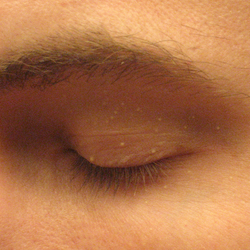Milium (dermatology)

Editor-In-Chief: Prab R Tumpati, MD
Obesity, Sleep & Internal medicine
Founder, WikiMD Wellnesspedia &
W8MD medical weight loss NYC and sleep center NYC
| Milium | |
|---|---|

| |
| Synonyms | Milia, milk spots |
| Pronounce | N/A |
| Specialty | N/A |
| Symptoms | Small, white, keratin-filled cysts |
| Complications | None |
| Onset | Can occur at any age |
| Duration | Can persist for weeks to months |
| Types | N/A |
| Causes | Keratin trapped beneath the skin surface |
| Risks | Newborns, burns, blistering injuries |
| Diagnosis | Physical examination |
| Differential diagnosis | Acne, epidermoid cyst |
| Prevention | None |
| Treatment | Exfoliation, retinoid creams, dermabrasion |
| Medication | N/A |
| Prognosis | Excellent |
| Frequency | Common |
| Deaths | N/A |
Milia (singular: milium), commonly referred to as milk spots or oil seeds, are small, keratin-filled cysts that form when the eccrine sweat gland becomes clogged. These cysts are located just under the epidermis or on the roof of the mouth. While milia are most commonly associated with newborn babies, they can affect individuals of all ages. They typically appear around the nose and eyes and can also be found on the genitalia, where they are often mistakenly identified as warts or symptoms of a sexually transmitted disease. Additionally, milia may be confused with stubborn whiteheads due to their similar appearance.
Causes[edit]
Milia form due to the accumulation of keratin, a protein that is part of the skin's structure, leading to the blockage of sweat glands. Factors contributing to their development can include skin damage from sun exposure, blistering injuries, or long-term use of steroid creams.
Symptoms and Identification[edit]
Milia are characterized by small, dome-shaped bumps that are white or yellowish. They are typically painless and present no health risk but can be a cosmetic concern for some individuals. Unlike whiteheads, milia do not form in pores but rather in areas where the skin layers have become trapped.

Treatment and Management[edit]
While milia often resolve on their own, especially in infants, persistent cases may require treatment. Options include:
- Professional extraction by a dermatologist
- Topical retinoids
- Chemical peels
- Laser therapy
It is advised not to attempt to remove milia at home, as improper handling can lead to skin damage or infection.
Prevention[edit]
Preventive measures include avoiding excessive sun exposure, using non-comedogenic skincare products, and maintaining a regular skin care regimen to encourage healthy skin turnover.
See Also[edit]
References[edit]
External Links[edit]
Ad. Transform your life with W8MD's Budget GLP-1 injections from $75


W8MD offers a medical weight loss program to lose weight in Philadelphia. Our physician-supervised medical weight loss provides:
- Weight loss injections in NYC (generic and brand names):
- Zepbound / Mounjaro, Wegovy / Ozempic, Saxenda
- Most insurances accepted or discounted self-pay rates. We will obtain insurance prior authorizations if needed.
- Generic GLP1 weight loss injections from $75 for the starting dose.
- Also offer prescription weight loss medications including Phentermine, Qsymia, Diethylpropion, Contrave etc.
NYC weight loss doctor appointmentsNYC weight loss doctor appointments
Start your NYC weight loss journey today at our NYC medical weight loss and Philadelphia medical weight loss clinics.
- Call 718-946-5500 to lose weight in NYC or for medical weight loss in Philadelphia 215-676-2334.
- Tags:NYC medical weight loss, Philadelphia lose weight Zepbound NYC, Budget GLP1 weight loss injections, Wegovy Philadelphia, Wegovy NYC, Philadelphia medical weight loss, Brookly weight loss and Wegovy NYC
|
WikiMD's Wellness Encyclopedia |
| Let Food Be Thy Medicine Medicine Thy Food - Hippocrates |
Medical Disclaimer: WikiMD is not a substitute for professional medical advice. The information on WikiMD is provided as an information resource only, may be incorrect, outdated or misleading, and is not to be used or relied on for any diagnostic or treatment purposes. Please consult your health care provider before making any healthcare decisions or for guidance about a specific medical condition. WikiMD expressly disclaims responsibility, and shall have no liability, for any damages, loss, injury, or liability whatsoever suffered as a result of your reliance on the information contained in this site. By visiting this site you agree to the foregoing terms and conditions, which may from time to time be changed or supplemented by WikiMD. If you do not agree to the foregoing terms and conditions, you should not enter or use this site. See full disclaimer.
Credits:Most images are courtesy of Wikimedia commons, and templates, categories Wikipedia, licensed under CC BY SA or similar.
Translate this page: - East Asian
中文,
日本,
한국어,
South Asian
हिन्दी,
தமிழ்,
తెలుగు,
Urdu,
ಕನ್ನಡ,
Southeast Asian
Indonesian,
Vietnamese,
Thai,
မြန်မာဘာသာ,
বাংলা
European
español,
Deutsch,
français,
Greek,
português do Brasil,
polski,
română,
русский,
Nederlands,
norsk,
svenska,
suomi,
Italian
Middle Eastern & African
عربى,
Turkish,
Persian,
Hebrew,
Afrikaans,
isiZulu,
Kiswahili,
Other
Bulgarian,
Hungarian,
Czech,
Swedish,
മലയാളം,
मराठी,
ਪੰਜਾਬੀ,
ગુજરાતી,
Portuguese,
Ukrainian


